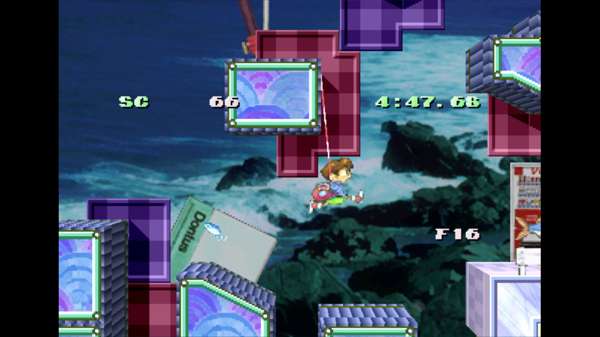
Umihara Kawase Shun PC Review
It’s pretty much a given at this point that Japanese publishers have finally embraced the digital golden goose that is Steam, as more and more classic and/or obscure Japanese games are finding themselves taking a seat at Gaben’s table as they feast on the all-digital banquet spread before them. The release of Umihara Kawase on Steam is particularly noteworthy as it predates Bubsy the Bobcat as the first Super Nintendo/Super Famicom title to hit Steam, while also being a far more entertaining 16-bit throwback that has stood the test of time. It’s a shame that Agatsuma Entertainment wasn’t able to also hang around, as the publisher responsible for localizing the quirky platformer series will soon be shutting its doors down.
At least they were able to get the final game in the Umihara series that had yet to reach the West with Umihara Kawase Shun just before they went under, though the game actually predates Sayanora Umihara Kawase, which was the first one to hit Steam despite being the last released game in the series. Originally released on the Playstation, Shun is the weird half-breed of the Umihara franchise, combining the sprite-based animation of its 16-bit ancestor while featuring the transition to 3D backdrops that would eventually overtake it entirely with Sayanora. This mish-mash of art styles has its own retro charm for those who grew up with PSX games…but that doesn’t necessarily mean it’s pretty to look at.

The story of Shun is every bit as nonexistent as the other titles; the titular Umihara (who, judging by the official artwork in chronological order, undergoes quite the growth spurt between games) once again finds herself navigating a twisted labrynthian version of her hometown as it is overrun with grotesque walking fish creatures of various shapes and sizes. Using her trusty fishing lure, she must swing her way across several death traps and bottomless pits while also fending off the land-based sea horrors in order to find the nearest exit. The usual motivations include hidden exits, collectible backpacks and leaderboards to master, though it’s going to take several hours of practice and Game Overs in order to get good enough.
Gameplay is the same as the other games, where the main draw is using the fishing lure to attach to nearby obstacles while manipulating the physics to pull and swing your way across various hazards. Compared to the other games, swinging feels slightly off in this iteration, which may be due to the uninspired level design; while previous games in the series did a respectable job of easing players into learning the ups and downs of grappling, Shun feels less forgiving while also feeling less fun. The game also lacks the stage saving feature of Sayanora, meaning that players only have a set amount of lives to make their way across all the stages before being forced to start over from the very beginning.
The other mark against Shun is the murky visual style, particularly the flat and unshaded backdrops; by making the foreground and background share the same color and shading, it often proves confusing to determine which platforms can be interacted with the lure and which are just part of the background. The character sprites, which are much taller and more detailed than the 16-bit original game, feature the typical blurry look that was prevalent during the 32-bit era. The music also lacks the catchiness of the other two Umihara games to boot.

Simply put, of the three Umihara Kawase games now available on Steam, Shun feels like the weakest link in the series. While the game still retains much of the charm and physics-based platforming that is a known quantity at this point, it also feels like an entry that is only worth looking into when you’ve mastered the other two games first. Having all three Umihara games on one digital platform is an appreciated effort, especially since not too long ago the West was completely devoid of the series, but Shun feels like a somewhat sour note to end on when Sayanora is the far better swansong for the series.
